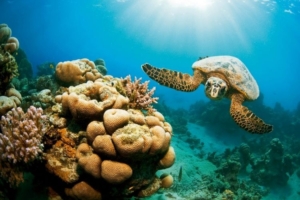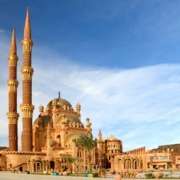Red Sea (The underwater paradise )
Red Sea: A Unique and Enigmatic Waterway
The Red Sea, a narrow body of water separating Africa from the Arabian Peninsula, stretches for approximately 1,200 miles from Suez, Egypt, to the Bab el-Mandeb Strait. Geologically, it extends north into the Gulfs of Suez and Aqaba.
Physical Characteristics
The Red Sea is renowned for its extreme temperatures and salinity. Its waters are some of the hottest and saltiest in the world. The sea’s name is derived from the reddish-brown hue it occasionally takes on due to blooms of the algae Trichodesmium erythraeum.
Climate of Red sea
The Red Sea region experiences a dry climate with minimal precipitation. Temperatures vary significantly throughout the year. Fall, winter, and spring offer pleasant conditions for outdoor activities, with temperatures ranging from 46 to 82 °F (8 to 28 °C). However, summer brings intense heat, with temperatures reaching up to 104 °F (40 °C) and high humidity.

Geology and Geography of Red sea
The Red Sea lies in a fault depression between the Arabian and North African tectonic plates. The land on both sides rises to over 6,560 feet above sea level, with the highest elevations in the south.
At its northern end, the Red Sea divides into two gulfs: the Gulf of Suez and the Gulf of Aqaba. The Gulf of Suez is shallow and has a broad coastal plain, while the Gulf of Aqaba is deeper and has a narrower plain. South of their convergence, the Red Sea’s main trough reaches depths of approximately 4,000 feet.
Importance and Traffic of Red sea
The Red Sea is a vital waterway connecting Europe and Asia. The Suez Canal, built in the 19th century, allows ships to pass between the Mediterranean Sea and Red Sea, making it one of the busiest shipping lanes in the world.
Marine Life of Red sea and Tourism
The Red Sea is home to a diverse array of marine life, including colorful coral reefs, numerous fish species, and marine mammals. Its warm, clear waters and stunning underwater landscapes make it a popular destination for snorkeling, diving, and other water sports.
The Red Sea is a seawater inlet of the Indian Ocean, lying between Africa and Asia. It is a unique body of water due to its extensive shallow shelves, noted for its vibrant coral reefs and marine biodiversity. Here are some details about the Red Sea:
Environmental Conditions
– Salinity: It has one of the highest levels of salinity in ocean waters due to the high evaporation rates and limited connection to the open ocean.
– Temperature: The water temperatures often range from 20°C (68°F) during the winter to 30°C (86°F) during the summer.
Historical and Economic Significance
– Trade Route: Historically, the Red Sea has been a crucial trade route between East and West. The ancient Egyptians reportedly used it for trade and navigation.
– Economic Resources: The Red Sea region is rich in resources such as oil and minerals. The coastal regions are also major hubs for the shipping and maritime trade, as well as tourism, especially for scuba diving and snorkeling enthusiasts.
Threats and Conservation
– Environmental Threats: Like many marine environments, the Red Sea faces threats from pollution, overfishing, and the impacts of climate change such as rising water temperatures and coral bleaching.
– Conservation Efforts: There are various marine protected areas established along the Red Sea to help preserve its natural habitat and biodiversity.
The Red Sea is notably one of the saltiest bodies of water on Earth, with very limited inflow of freshwater. It’s also one of the world’s hottest and most saline seas. Due to its unique ecosystem and beautiful underwater scenery, it is a popular destination for divers and researchers. Its vibrant coral reefs and clear waters make it one of the best places for coral reef and marine life observation.
Written by ATW Updated June 2024








